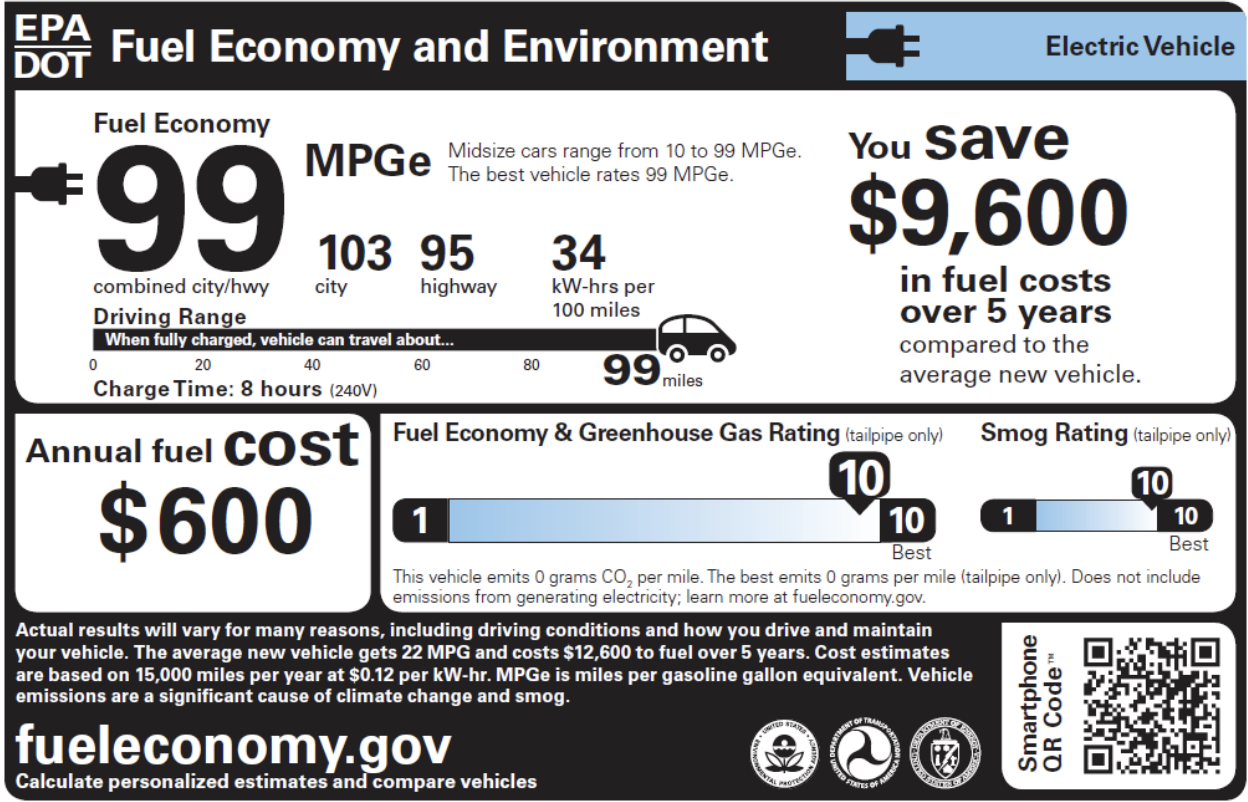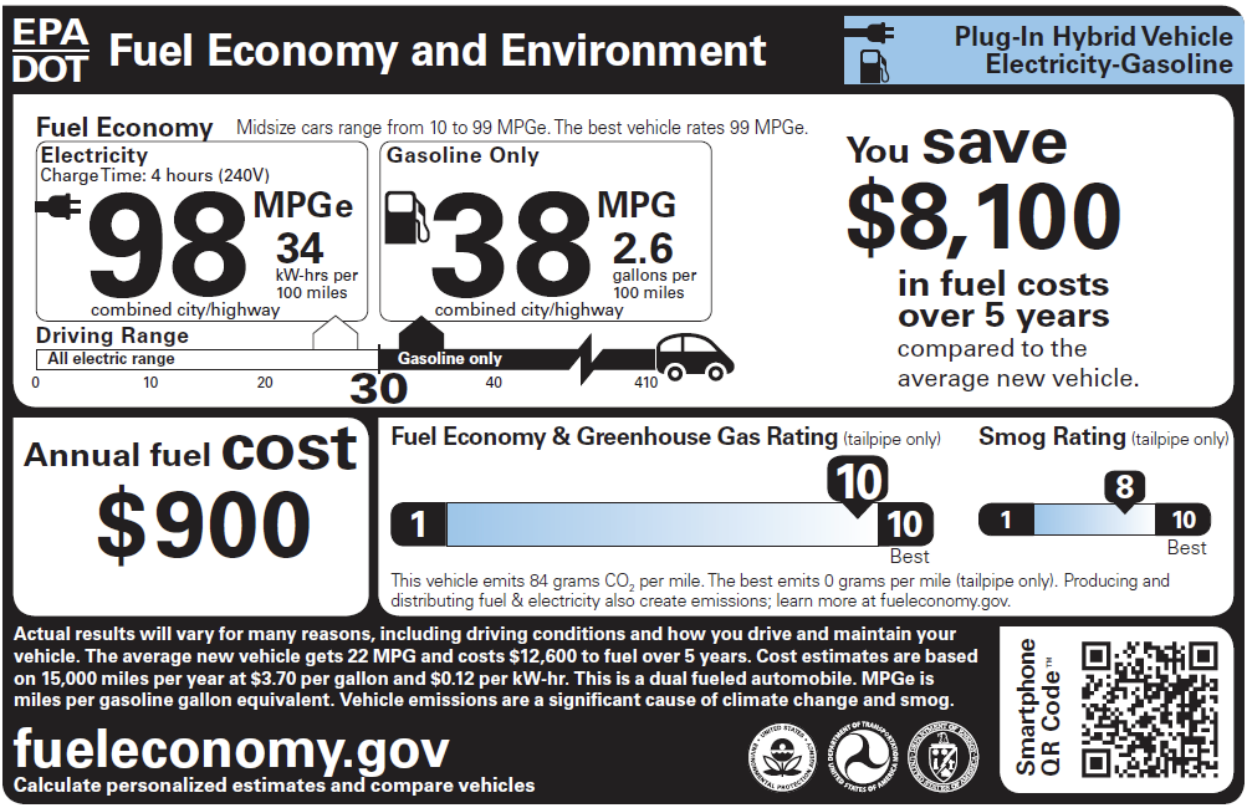All-Electric Vehicle Model Fuel Efficiency Performance from 2019 to 2024
EPA Fuel Economy and Environment Label
With the increasing adoption of cleaner energy sources, the US Environmental Protection Agency (EPA) has unveiled a new Fuel Economy and Environment Label for new vehicles since 2012. This label provides useful information on fuel economy, fuel cost, and environmental impact, helping drivers choose the most efficient vehicle that meets their needs. In addition, driving range and charging time are also displayed for electric vehicles.
Electric Vehicle Fuel Efficiency Performance
Fuel Economy: Miles per gallon gasoline equivalent (MPGe)
The vehicle label normally starts by displaying miles per gallon (MPG) or miles per gallon of gasoline-equivalent (MPGe), with city, highway, and combined values. The combined fuel economy is the weighted average of city (55%) and highway (45%), which makes vehicle comparison easier.
Similar to MPG used by gas-powered cars, electric-powered vehicles display fuel economy using MPGe to ensure accessible comparison across different power sources. MPGe could be easily understood as the number of miles the vehicle can travel using a quantity of fuel with the same energy content as a gallon of gasoline.
Fuel Consumption Rate: Kilowatt-hours (kWh) / 100 miles
Kilowatt-hours (kWh) is a unit used to measure electricity energy usage. The value on the Label indicates how many kilowatt-hours the vehicle uses to travel 100 miles. It is highly related to the amount of electricity consumption and thus to fuel costs. The lower the fuel consumption rate, the more fuel costs are saved annually. In conventional vehicles, unlike the linearity in Miles per Gallon (MPG), Gallons per 1000 Miles always decrease non-linearly as MPG increases linearly. Therefore, a fuel consumption metric allows for more accurate energy usage comparisons among vehicles.
Fuel Economy Rating
The Fuel Economy rating on the Label is accompanied by GHG rating. There is a positive relationship between these two factors: a higher fuel economy is associated with a better GHG emissions profile. However, as all-electric vehicles do not have tailpipe emissions (detailed in the next section), we can simply assess their fuel economy performance in general.
Prior to 2023, according to EPA data, fuel economy scores were consistently rated 10 (best) for all electric-powered car models. Starting in 2023, the EPA has assigned scores of 8 and 9 to some of them. By examining the distribution of combined MPGe and fuel consumption rate among different scores, it appears that the scoring rules have become stricter over the years.
Electric Vehicle Environmental Impact
In the redesigned label, the EPA also provides ratings for vehicle emissions in terms of greenhouse gases and smog, with a scale of 1 (worst) to 10 (best).
Greenhouse Gas Rating
The GHG rating is a score that only reflects greenhouse gas emissions, with 99% of carbon dioxide, emitted from the tailpipes of cars and trucks that combust fuel. Based on the definition of the rating, all-electric vehicles are one of the cleanest vehicle groups as they are zero-emission ones. This means that they produce no tailpipe emissions, even though upstream emissions are generated during the production and distribution of electricity.
Check out upstream emissions in your neighborhood: Beyond Tailpipe Emissions Calculator
Smog Rating
Smog is a haze-like form of air pollution that threatens human health, produced by various compounds such as oxides of nitrogen and particulate matter (PM). These are emitted during fuel combustion as well. The smog rating is a measure for vehicle tailpipe emissions of those air pollutants. It follows either federal (Clean Air Act) or California (stricter regulations than CAA) emission standards that incorporate specific thresholds for covered compounds. Since electric vehicles have no tailpipe emissions, they also have no smog-forming emissions.
All-Electric Vehicles Fuel Efficiency Dashboard
Reference
- EPA Fuel Economy Label Introduction
- Electric Vehicle: Learn More About the Label (EPA)
- Environmental Impact: GHG Rating and Smog Rating (Drive Clean)
- Electric Vehicle Benefits and Considerations (Alternative Fuel Data Center)
- Vehicles, Greenhouse Gases and Smong (EPA)
- GHG Emissions Calculator - Beyond Tailpipe (EPA Fuel Economy)


